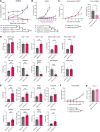N-glycosylation by Mgat5 imposes a targetable constraint on immune-mediated tumor clearance
- PMID: 38912584
- PMCID: PMC11383181
- DOI: 10.1172/jci.insight.178804
N-glycosylation by Mgat5 imposes a targetable constraint on immune-mediated tumor clearance
Abstract
The regulated glycosylation of the proteome has widespread effects on biological processes that cancer cells can exploit. Expression of N-acetylglucosaminyltransferase V (encoded by Mgat5 or GnT-V), which catalyzes the addition of β1,6-linked N-acetylglucosamine to form complex N-glycans, has been linked to tumor growth and metastasis across tumor types. Using a panel of murine pancreatic ductal adenocarcinoma (PDAC) clonal cell lines that recapitulate the immune heterogeneity of PDAC, we found that Mgat5 is required for tumor growth in vivo but not in vitro. Loss of Mgat5 results in tumor clearance that is dependent on T cells and dendritic cells, with NK cells playing an early role. Analysis of extrinsic cell death pathways revealed Mgat5-deficient cells have increased sensitivity to cell death mediated by the TNF superfamily, a property that was shared with other non-PDAC Mgat5-deficient cell lines. Finally, Mgat5 knockout in an immunotherapy-resistant PDAC line significantly decreased tumor growth and increased survival upon immune checkpoint blockade. These findings demonstrate a role for N-glycosylation in regulating the sensitivity of cancer cells to T cell killing through classical cell death pathways.
Keywords: Apoptosis; Cell biology; Glycobiology; Oncology; T cells.
Conflict of interest statement
Figures






References
-
- Gagneux P, Hennet T, Varki A. Biological Functions of Glycans. In: Varki A, Cummings RD, Esko JD, et al., editors. Essentials of Glycobiology [Internet]. 4th edition. Cold Spring Harbor (NY): Cold Spring Harbor Laboratory Press; 2022. Chapter 7. Available from: https://www.ncbi.nlm.nih.gov/books/NBK579984/
MeSH terms
Substances
Grants and funding
LinkOut - more resources
Full Text Sources
Medical
Molecular Biology Databases

